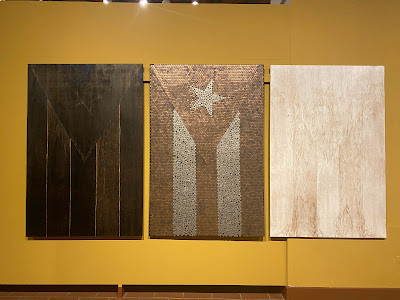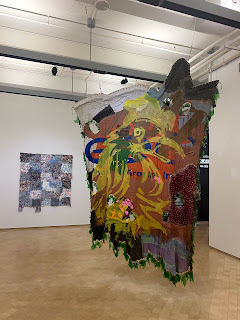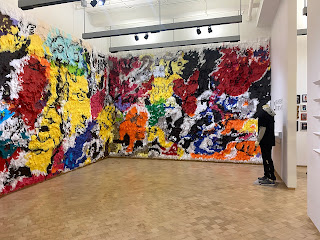Moving through this pandemic period has been weirder than I originally thought. Not that I knew what to expect. I was going to grad school during the brunt in early 2020 and frankly, staying home alone, writing my MA thesis, attending classes on Zoom, and working remotely was not that hard for me. Graduating on Zoom was not ideal. And of course, I am not even touching on the overall dangers and consequences of the Coronavirus pervading our city, and the world. But for me (and yes, I am an introvert), staying home, watching TV, cooking, painting, meditating, taking long neighborhood walks, and wearing a mask, was absolutely fine. Enjoyable, even. I was actually very productive throughout the entire year of 2020.
And let’s not forget the multitude of BLM-related marches and protests, of which I made it to quite a few in NYC. I even made it to Washington, DC for the historic Commitment March in commemoration of Dr. Martin Luther King Jr’s “I Have a Dream” speech, which was tremendous. Yes, 2020 was a tough year, but some diamonds were made under the pressure, too.
However, 2021 has been much more challenging for me. I’m no longer a grad student, which is bittersweet. I've been job-searching, but that has been challenging, as cultural organizations have been heavily affected by the pandemic. I moved into a new apartment in early-2021 which was an improvement in many ways. But still a big change; my routine has changed - and coupled with the fact Covid restrictions abound, going to places and doing things I usually like to do has been curbed. I’ve felt a general malaise, I think, because of how long this “reopening of NYC” has been taking. We are still in the midst of a pandemic almost two years later. Life has changed.
While I was unable to go out and visit museums and galleries or the most part, I engaged with art in whatever ways I could. The enormous importance of public art and street art could not have impressed upon me more. Cultural institutions made use of Zoom and other online platforms and I soaked in as much as I could, until I got Zoomed-out. Being interested in Latinx art, I was happy to see that a number of books related to this subject were published recently, and so I’ve been acquiring them one by one. Truth be told, I started reading all, but have not finished any (I’ll blame it on
pandemic brain-fog), so I cant review them per se. Nonetheless, I have inadvertently been building a little library of Latinx art and these are all lovely, thoughtful books, I believe will stand the test of time.
Before I go further, I should address the meaning of "Latinx" as it pertains to art, for those who might not be aware of the distinction. According to Aldeide Delgado:
..."Latinx" is a concept that does not pertain to Latin America, nor does it pretend to define the artistic or social processes in the region. It does however facilitate the inclusion of these debates in the discourse on Latin America and the Latin American diaspora. "Latinx" includes people who have been born, educated or naturalized in the United States... Latinx artists recover shared cultural experiences to reflect on class, migration and identity issues. Latinx art does not define a monolithic identity, nor is it about single story or experience. Rather, this art is marked by various factors of gender, mobility, migratory status, skin color and access to cultural and economic capital. Studying Latinx art involves recognizing the influence of these artists on the history of American art, as well as generating a space for dialogue and discussion about the politics of access and participation of the Latino communities in US society. ("What Is "Latinx"?" Contemporary & AL, 2019.)
Not so coincidentally, one of the first IRL art exhibits I visited this year was at
El Museo del Barrio for Estamos Bien – La Trienal 20/21 – a large-scale survey of Latinx art curated by Rodrigo Moura, Susanna V Temkin, and guest curator Elia Alba. It’s no secret that El Museo is one of my favorite cultural institutions. I even had the opportunity to intern there in 2019. So, returning to the building in person this July felt a bit nostalgic. And I was thrilled to see that they have added on an entirely new, huge gallery to help encompass this expansive exhibition. I don’t fancy myself an art critic, so I’ll save you from my opinions on the particular pieces. But I will instead include some photos I took of the works featured at La Trienal, as well as a few links to articles about the exhibit.*
I will also post some info about the aforementioned books I’ve acquired about Latinx and BIPOC art, for those who may be interested in bolstering their own libraries:
Latinx Art: Artists/Markets/Politics by Arlene Dávila;
We Are Here: Visionaries of Color Transforming the Art World, by Jasmin Hernandez;
Raphael Montañez Ortiz; a monograph about founder and first director of El Museo del Barrio; and
Estamos Bien: La Trienal 20/21 featuring the work of the 42 participating artists and collectives included in the exhibition.
Overall if there is one thing I've learned during this pandemic time, it's that is is okay to slow down. I have always been a person who is "overly busy" doing a million things at once, always stacking my time, responsibilities, and appointments. I prided myself on being productive. The pandemic has created space for me to slow down and think, without necessarily fill up every moment with busy-ness. And still somehow certain themes arise - for me, at this time, it's been Latinx art. As a fellow Latinx artist myself, and cultural worker, it sparks joy and inspiration that this category is gaining notability and challenging the traditional art canon.
*Articles about Estamos Bien – La Trienal 20/21:
-
El Museo Looks to Define ‘Latinx Art’ With a Major Survey - NY Times
-
El Museo’s Triennial Gathers Works That Defy Pervasive Stereotypes Mapped onto Latinx Art - Hyperallergic
-
Veering From the Didactic to the Lyrical, El Museo del Barrio’s Worthy New Triennial Defines Latinx Art Through a Common Struggle - ArtNet
All photos by Lorie Caval, taken at El Museo del Barrio, July 2021

























































